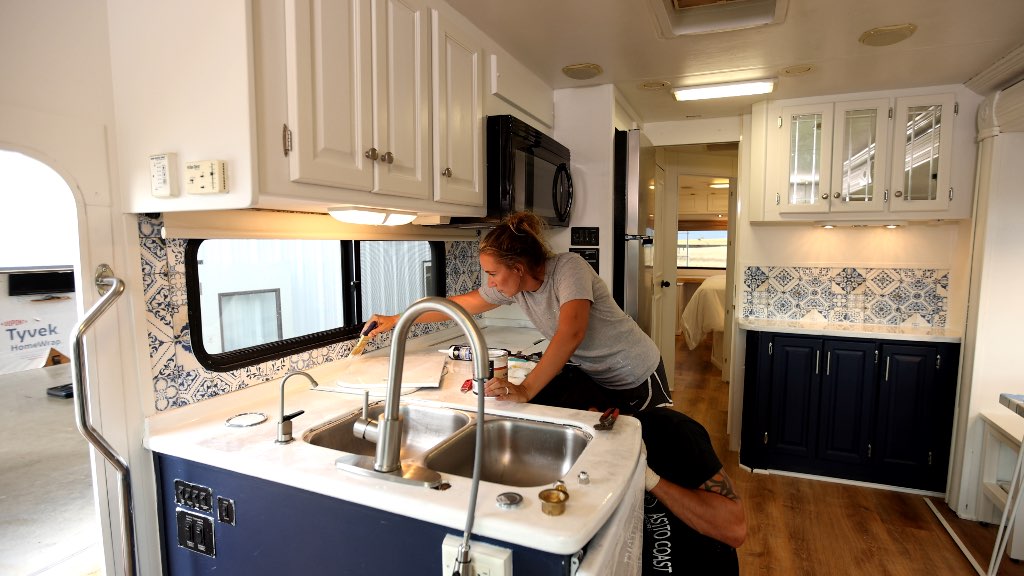Tech Q&A – November, 2022
Current Draw From an RV's A/C, a Weathered Toy-Hauler Ramp, a Missing Diagram, and an A-Frame Toolbox
Image Caption:
Air Conditioner on House Current
Q: In 2005, we purchased an R-Vision Trail-Lite hybrid and enjoyed it for 15 years. In 2020, we upgraded to a 2018 Rockwood 2509S travel trailer. The air conditioner was never tested on our home circuit because the 2005 always tripped a circuit breaker. I was in the process of purchasing a soft start to be able to use the A/C during prep for trips. In 2005, while outfitting our new hybrid, I had purchased a 25- foot, 30-amp extension cord for extra-long power runs, but I never used it.
Recently, while disconnecting after a 10-day trip, I heard something running. I discovered the A/C had been left on accidentally, and when I plugged into the house using the extension cord, it came on. I had never tried the A/C on house current because the previous trailer would pop circuit breakers. I turned the A/C off. I cycled it a couple of times, and it ran without a problem. I suspect the difference was the use of the 25-foot, 30-amp RV extension cord that I bought years ago for emergencies (I hadn’t used it until then). It saved me $300 on a soft start kit.
Was this a fluke, or was it because the heavy-duty RV extension cord allowed the A/C to work on house current? I wanted to share this with others that it may be able to save some expense to use the A/C on house.
—Jack Price, via email
A: When the air conditioner starts, it draws far more current than when running. Using an undersized power cord reduces the amount of available starting voltage, which further increases amperage requirements. This may have been the cause of the breaker tripping on the first trailer. Some air conditioners, particularly the newer ones, require less starting and running current than older ones of similar size. However, without being able to perform a comparison test with both trailers, it’s not possible to say for sure.
A soft start is still a good investment for those times when your RV is connected to a sketchy power source. It also saves some startup wear and tear on the A/C, so it’s a worthwhile purchase.
Toy Hauler Ramp
Q: I have a 2006 Keystone Raptor toy hauler. The ramp is wet and swollen where the hinges mount. I emailed Keystone, and all they said was they haven’t heard of that before and that it may be time to get a new trailer. Somehow water is getting into the ramp. Could it be condensation? I don’t see any drain holes. It needs to be repaired, but I want to fix the water intrusion first.
—Dan Baker, via email
A: Keystone was founded in 1996 and bought by Thor in 2020. They currently offer a three-year structural warranty, so you’re out of luck there, as I’m sure you know.
You didn’t mention what city and state you keep it in, so I can’t use that information on climate to help figure out what is happening to the ramp. Unless you live in a very wet, swampy area, I suspect the problem is caused by rain entry. Carefully inspect the weatherstripping and sealants all around the ramp/tailgate.
I suggest you try to dry out the affected area (you might need to place a tarp or cover over it for a while to keep rain off). Once it is dry, have an assistant inside to watch for water intrusion, and spray a garden hose all over the outside of the rear of the coach, simulating the way rain would hit it. Look for any gaps or voids where water can enter. Once you find the problem, you may want to repair it yourself or take it to a shop that specializes in RV body repairs.
Keystone RV’s customer service can be reached at (866) 425-4369.
Winnebago Wiring Diagram
Q: We have a 2020 (made in 2019) Winnebago Spyder 23FS toy hauler, which is not listed in the online Winnebago wiring diagrams library. I have searched the Winnebago website for other things concerning this rig, and I believe someone else made this toy hauler and just slapped the Winnebago name on it. Am I right, or is this listed on its website elsewhere?
—David Cardenuto, via email
A: The online wiring diagrams listed on the website are for Winnebago motorhomes (made in Forest City, Iowa), not Winnebago towables. Winnebago makes its towable product line in Middlebury, Indiana, and for whatever reason, does not provide wiring diagrams for them online. I contacted the Winnebago Towables division’s customer service at (574) 825-8052 on your behalf and had them send you a request for your trailer’s 17-digit VIN and phone number. They will work directly with you to get the information you need. This information is required by Winnebago customer service upon initial contact, and owners with inquiries should have the VIN available when requesting assistance.
Excessive Tongue Weight
Q: We have a front-wheel-drive Hyundai Palisade with a towing package, and with less than 5,000 miles on the odometer. Our trailer is a 2019 Liberty Outdoors Mini Max teardrop trailer. When we bought our trailer, the dealer offered to add a large toolbox on top of our trailer’s tongue (A-frame). They installed two propane tanks, two batteries, and a power A-frame jack. My trailer repair shop told me the tongue weight was about 450 pounds. I removed the extra propane tank, replaced the remaining 5-gallon propane tank with a 2.5-gallon tank, removed the extra battery, and moved all the heavy items (such as tools) to the storage bin at the rear of the trailer. When I attach the trailer to our car, the rear of the car still drops about 4 inches despite the load leveler feature in our SUV. On two-lane roads at night, oncoming cars frequently flash their bright lights at me even though I am using the low beams.
The tires were in great condition but are wearing rapidly. And, to add insult to injury, when I had the first four-wheel alignment done today on the SUV, they told me, “Whatever you are towing is causing alignment issues on the rear wheels.” We primarily use this SUV as our vacation car, and it has towed our trailer every vacation for the past year.
Is it time to cut my losses and have the toolbox removed from the trailer (see attached photo)? I could probably put a roof rack on our SUV to store the light items (ground cloths, hoses, plastic leveling blocks, etc.) that I currently store in the toolbox.
—Robert Sigal, San Diego, California
A: According to this 2019 test article, your trailer’s maximum gross trailer weight is 2,900 pounds, and tongue weight is 280 pounds stock. So you should be able to tow it with your Palisade, which (with the tow package) is rated to tow a trailer with brakes up to 5,000 pounds.
You didn’t mention what year model Palisade you have. Earlier models show a 350-pound maximum tongue weight. Later manuals show a maximum tongue weight of 500 pounds.
If your estimate of current tongue weight is 450 pounds (this should be verified), and the rear of the vehicle drops 4 inches when hitching up, that’s excessive, and something needs to be done. The storage box shown in the photo is the type commonly used behind the cab of a pickup and is quite heavy. That needs to go, along with the heavy items you mentioned. However, to maintain a safe balance, trailer weight should be distributed with 60% forward of the axle centerline and 40% aft of it. Tongue weight should be about 10% of overall trailer weight; a tail-heavy trailer can easily sway out of control.
If you transfer heavy items to the tow vehicle, place them low and forward as much as possible. Propane must not be carried in the passenger compartment. Also, the maximum gross rear axle weight is 3,159 pounds (see tag on door jamb). That should be checked on a truck scale to make sure it’s not exceeded when fully loaded with fuel, cargo, passengers, and trailer.
In addition, buy a weight-distributing (WD) hitch and have it properly adjusted when installed. Several WD hitches are designed for lighter-weight trailer-and-tow-vehicle combinations. The WD hitch will solve or seriously reduce most of the towing stability, tire wear, and headlight-aiming problems.
Lippert PSX2 Stabilizing Jack Problem
Q: I have a 2021 Forest River Flagstaff Micro Mini model 25FBLS with Lippert PSX2 stabilizer jacks. Three of the four jacks work great, but one of them does not come down. Any ideas on how to rectify this problem?
—Ed Umberger, Schuylkill Haven, Pennsylvania
A: Look underneath at the nonworking jack. Is the screw mechanism or any other part damaged or twisted? When the switch is operated, does the electric motor make noise, like it is trying to work? If the motor is trying to work, the mechanism may be jammed. If it appears intact and the motor doesn’t make any noise when activated, check for voltage going to the motor when the switch is on. The most common problems are bad switches and connections and physical damage, often from overloading them.
They are designed only to stabilize the coach, not lift and level it. Here’s a YouTube instructional video of the use and care of the stabilizer. It also tells how to extend it manually. Based on the age, if undamaged it may be eligible for warranty repair.
Follow the manufacturer recommendations concerning lubrication. Many stabilizing jacks are almost devoid of lubrication from the factory, especially the screw drive shaft , and rust can quickly start up and make it much harder for the drive motor to operate. Use something like a “dry lubricant” such as a graphite-based product on the screw threads to avoid the dirt and grit buildup that can occur if you use a “wet” grease or oil lubricant.
Five Dead Electrical Outlets
Q: We have a 2002 Holiday Rambler Ambassador motorhome. Five 120-volt AC receptacles stopped working. One is for the power converter underneath in the converter bay, three are in the bedroom, and one is under the dining table. I checked both GFCIs near the sinks, reset and tested them, and both work ne. Resetting and checking the circuit breakers in the coach did not solve the problem. Has anyone had this problem or know how to solve this issue?
—Wade Cooper, Chicago, Illinois
A: The two most likely causes of a string of dead outlets like this are a tripped GFCI or a tripped circuit breaker. A third and much less likely cause would be something like a wire that became disconnected at the beginning of the string of outlets.
My initial reply to Wade was: “If it’s not a circuit breaker, it pretty much has to be a GFCI hidden somewhere. Please try to look around more and check every outlet and GFCI carefully. Let me know what you find.”
I soon heard back from Wade: “Hey Ken, you were right on spot. It was a GFCI that I half-checked. I checked the line receptacle and didn’t check the load receptacle of that outlet. The test and reset button worked fine, but the power wasn’t passing through. You saved me a boatload of money. I will cancel my RV appointment tomorrow morning.”
Reader Comment — Trailerlegs
I read the “TrailerLegs Tire Protector” letter in the August issue. A word of caution, you might want to mention that many trailers prohibit jacking the rig anywhere but the frame. That means not on the axle, not on the spring pad, nor anywhere but the frame. My Outdoors RV 24RLS owner’s manual has a warning on this issue. So yes, Mark Condon might damage the axle by storing as you suggested.
—Steve Albert, via email
Thanks for writing to us. I looked through that owner’s manual, and the only reference to jacking I saw was this: “If after-market stabilizer stands are used, they must be placed only under the chassis frame rail. Do not place these stands in any other location as damage may occur, which will not be covered under warranty.” This does not apply to jacking or lifting, such as routine tire service. It basically warns against placing a stabilizer stand under a location such as an unreinforced floor.
Water Leak—Comment
This is regarding the “Water Leak” letter in the August issue about a 2015 Jayco losing freshwater on the road. We have a 2007 Jayco BH27. It lost freshwater on the road, and I finally noticed in the side mirror that water was pouring out of the tank’s under-trailer vent hoses when going around corners. I went to a hardware store and purchased two plastic fittings that fit into the hoses and two caps. I installed the fittings and secured them with hose clamps. The problem was solved for just a few dollars and has been good for several years. I reach under and remove the caps when filling the tank and replace them when done watering up.
—Tim McCormick, Colville, Washington
Thanks for taking the time to write to us. You may have been lucky to avoid the following problems: Perhaps you don’t use much water from the tank or vary altitudes much. The tanks have vents for several reasons, not just filling. When a large amount of water is drawn out of the tank, without a vent it could cause a partial vacuum in the air within the tank.
Also, when the barometric pressure changes significantly, as it does if you change altitude by several thousand feet, it could raise relative pressure (ascending) or lower it (descending). is could cause the pump to be unable to draw water. The large tank surface areas could result in serious distortion of the tank as a result of significant pressure changes.
This could result in the cracking of the tank, especially as it gets older. Therefore, I recommend running vent tubes up high if possible and keeping them open. If necessary, put a small hole to act as a restriction in the end cap, to allow for slower pressure balancing without allowing large water loss.
If you have access to the area, consider adding an inverted P-trap to the overflow vent line. Most fresh-tank overflow outlets are on the tank side near the top. When the water sloshes that way, it simply runs a bit out of the downward-facing vent line. Start with a 90-degree fitting at the tank outlet, aimed up. Add perhaps a foot of line straight up, then do a U-turn with fittings, then route the new line back down more or less to its original location. Add a small air filter or breather, available at auto parts stores, to the end of the line to keep dust and insects out of the tank while allowing the excess water to drain through.
When the freshwater casually sloshes toward the overflow port, it needs to travel all the way up to the U-turn before draining out. This will significantly reduce over-the-road sloshing leakage while allowing free water flow when filling the tank and equalizing the air pressure due to the altitude variations mentioned previously.
Water Leak—Another Comment
Regarding the letter from Glenn Brown in the August issue about a leaky water tank, my unit is a Forest River Grey Wolf 20RDSE travel trailer. I read with interest the problem Glenn is having with his fifth wheel’s leaky freshwater tank. I encountered the same problem, especially when traveling in hilly country. I solved it by adding a simple ball-style valve on the end of the vent hose. I extended the vent hose so it exits just in back of the rear tire and added the ball valve at the end. I open the valve when camping and filling the holding tank. I close the valve for travel. I can open and close it by kneeling and simply reaching under the camper. No more lost water for me. I hope this helps others.
—Mark Klevene, Nekoosa, Wisconsin
Thank you for writing, Mark. Please see the previous letter and answer about this subject.





